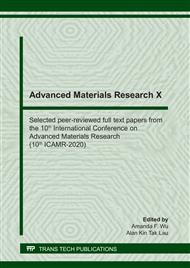p.102
p.109
p.115
p.120
p.126
p.131
p.142
p.150
p.157
Characterization of Alkali-Treated Banana Fiber and its Effects as Web Reinforcement on the Axial Load Capacity of Concrete
Abstract:
The Philippines is an agricultural country due to its location in the tropics. Because of this nature, the agriculture sector tends to produce a huge amount of waste that if not disposed properly could pose a threat to the society and to the environment. Studies have been performed on the possibilities of incorporating agricultural wastes to various construction materials as a form of waste diversion. In order to address the problem with agricultural wastes as well as to improve the property of construction materials, a study on alkali-treated banana fiber as web reinforcement in concrete was done. In this study, a characterization of alkali-treated banana fiber was done in order to assess the characteristics of a possible reinforcement for concrete by tensile strength test on the fiber. The applicability of the treated fiber was then examined as a web reinforcement in concrete in terms of its load capacity. The parametric study was conducted to investigate the effect on the compressive strength of varying bundle diameter (4 mm, 8 mm, 12 mm, 16 mm) while holding the spacing of mesh at 20 mm and also the effect of varying mesh spacing (10 mm, 15 mm, 20 mm and 25 mm) while holding the diameter at 16 mm. Test results show that the 4 mm diameter of treated banana fiber yielded the highest tensile strength at 314 N compared to only 197 N of the untreated banana fiber. The parametric study results the diameter of banana fiber indicate that the increase in diameter also results in the increase in load capacity. With respect to spacing, the smaller the value of spacing results in higher load capacity.
Info:
Periodical:
Pages:
126-130
Citation:
Online since:
July 2020
Keywords:
Price:
Сopyright:
© 2020 Trans Tech Publications Ltd. All Rights Reserved
Share:
Citation:


